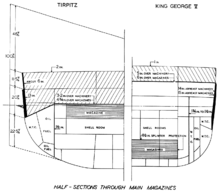Belt armor

Belt armor is a layer of heavy metal armor plated onto or within the outer hulls of warships, typically on battleships, battlecruisers and cruisers, and aircraft carriers.
The belt armor is designed to prevent projectiles from penetrating to the heart of a warship. When struck by an artillery shell or underwater torpedo, the belt armor either absorbs the impact and explosion with its sheer thickness and strength, or else uses sloping to redirect the projectile and its blast downwards.
Typically, the main armor belt covers the warship from its main deck down to some distance below the waterline. If, instead of forming the outer hull, the armor belt is built inside the hull, it is installed at a sloped angle for improved protection, as described above.
The torpedo bulkhead

-_Salvage%2C_12-31-43%2C_7126-43%2C_Port_side_at_about_fr_60_after_removal_of_main_patch_in_drydock_-_NARA_-_296956.jpg)
Frequently, the main belt's armor plates were supplemented with a torpedo bulkhead spaced several meters behind the main belt, designed to maintain the ship's watertight integrity even if the main belt was penetrated. Furthermore, the outer spaces around the main belt in some designs were filled with storage tanks that could contain fuel oil, seawater, or fresh water. The liquids in these tanks absorb or scatter much of the explosive force of warheads and shells. In other designs, the outer spaces were left empty, allowing some the initial blast wave to dissipate, while the inner liquid layers then absorbed shrapnel and spread the shock wave out over a larger area. To deal with the leakage from the tanks and incoming seawater, an armored holding bulkhead prevented liquid from entering other parts of the ship. This multilayer design is featured in the cross-sectional drawings of Tirpitz and King George V.[1]
In combat, a warship can be seriously damaged underwater not only by torpedoes, but also by heavy naval artillery shells that plunge into the ocean very close to the targeted ship. Such shells, especially armor-piercing shells, can pass through a short stretch of water, strike the warship some distance below her waterline, and detonate there with destructive effect similar to a torpedo. To improve protection against both shells and torpedoes, an air space can be added between the armor belt and the hull to increase the buoyancy of the warship.
Thinning the belt armor
Some kinds of naval warships have belt armor thinner than actually necessary for protection against projectiles. This is common especially with battlecruisers, battleships, and aircraft carriers to reduce their weight, thus increasing their acceleration and speed. Another possible reason is to meet treaty restrictions on ship displacement. One such method is all-or-nothing armoring, where belt armor is stripped from areas deemed non-vital to the functioning of the ship in battle. Agility gained from such processes are a great asset to offensive warships that seek to quickly bring their heavy striking power to the enemy.
In carriers, the maneuverability is exploited when deploying and recovering aircraft. Since planes take off and land most easily when flying into the wind, the aircraft carrier steams rapidly into the wind in both maneuvers, making take-off and landing safer and easier. To this end, nearly all large aircraft carriers have had speeds of 30 knots or more: for example, the sister ships USS Lexington and USS Saratoga, the second and third aircraft carriers to enter the U.S. Navy, in 1927.